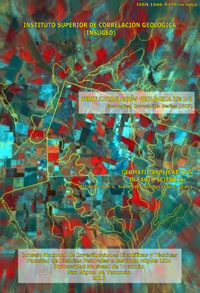Serie Correlación Geológica 33
Metodología de análisis mediante el uso de información satelital de la estructura y morfología del sector norte del batolito de Achala y su encajonante metamórfico, Sierras Pampeanas de Córdoba
Ernesto Guillermo Abril | Roberto D. Martino | Ana Caro Montero | Alina Beatriz Guereschi
Descargar trabajo en formato PDFResumen
El desarrollo de la tecnología satelital, con software específico y la gran difusión de imágenes satelitales junto con modelos digitales del terreno, han permitido un gran avance en la planificación territorial del suelo para usos agronómicos y urbanos, el desarrollo de mapas específicos de riesgos naturales. Dentro del campo de la geología, ha llegado a ser una herramienta de trabajo extremadamente útil, que sabiendo hacer uso de ella, permite el estudio de unidades geológicas y tectónicas a escala regional e incluso global, las cuales, debido a sus dimensiones, no han podido observarse desde una perspectiva más amplia. Las herramientas de procesamiento digital, a través de algoritmos, permiten discriminar unidades litológicas, escarpes de fallas y lineamientos estructurales, calcular la red de drenaje, y muchas otras posibilidades que permiten el estudio de grandes unidades geológicas, así como sus relaciones con las adyacentes. Aplicando este método de trabajo sobre el sector norte del batolito de Achala y su encajonante metamórfico, en la Sierra Grande de Córdoba (Sierras Pampeanas Orientales), se han podido aportar valiosos datos sobre la fracturación, la morfología y la estructuración en bloques, debido a la actividad tectónica del lineamiento Retamito y otros lineamientos menores paralelos. El uso de modelos digitales del terreno ha sido clave para evaluar la traza de dichos lineamientos a través del área estudiada, constatando su rumbo noroeste y su extensión por más de 80 km, segmentando el batolito por su parte media, así como para obtener la estimación del salto topográfico de más de 400 m entre los dos grandes bloques y su basculamiento en sentido horario. Key words: Remote sensing. Analysis satellite. Sierras de Córdoba.
Abstract
METHODOLOGY OF ANALYSIS THROUGH THE USE OF SATELLITE INFORMATION ON THE STRUCTURE AND MORPHOLOGY OF THE NORTHERN SECTOR OF THE ACHALA BATHOLITH AND ITS METAMORPHIC HOST ROCKS, SIERRAS PAMPEANAS OF CÓRDOBA. The satellite technology development, with specific software associated and the great diffusion of satellite images along with digital terrain models have allowed a great advance in the territorial land planning for agronomic and urban uses, the development of natural hazards specific maps. Within the field of geology has become an extremely useful work tool, which, knowing how to make use of it, allows the study of geological and tectonic units at regional and even global scale, which due to their dimensions have not been observed from a broader perspective. The digital processing tools, through algorithms, allow to discriminate lithological units, fault slopes, structural lineaments, drainage network, and a long list of possibilities that allow the study of large geological units, as well as their relations with adjacent ones. Using this methodology on the northern sector of the Achala batholite and its metamorphic field rocks, in the Sierra Grande of Córdoba (Sierras Pampeanas Orientales), valuable data on faulting, morphology and block tilting, due to the tectonic activity of the Retamito lineament and other parallel minor ones, have been provided. The use of digital terrain models has been useful to evaluate the traces of these lineaments throughout the studied area, verifying its northwest trend and its extension by more than 80 km, segmenting the batholith by its middle part, as well as to obtain the estimate of the topographical throw of more than 400 m between the two large blocks and their clockwise tilting.






